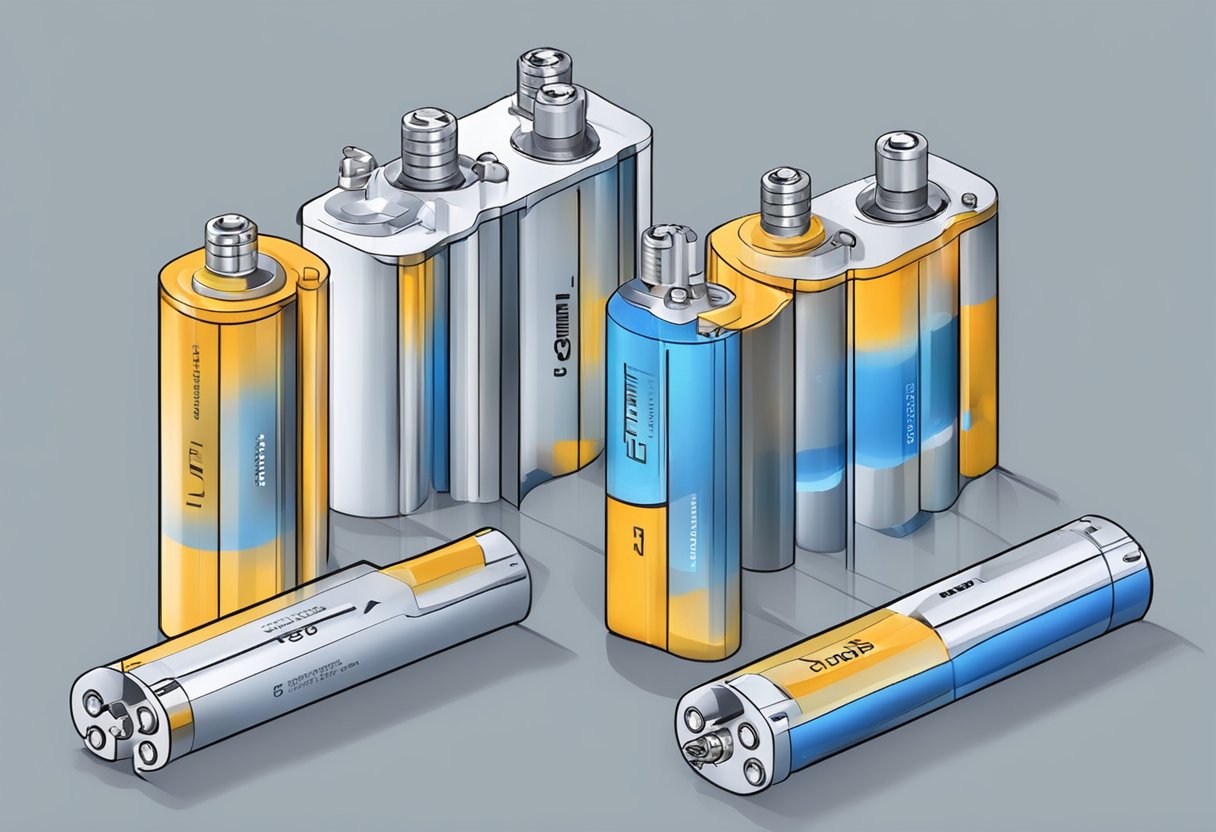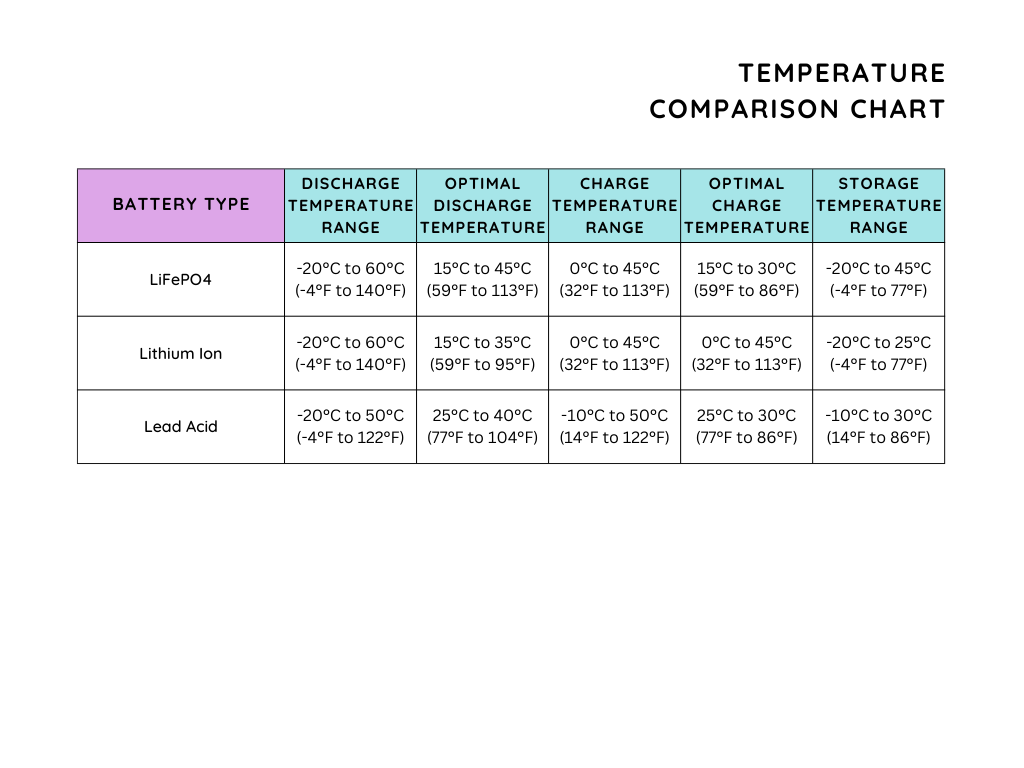Comparing Temperature Stability: Do LiFePO4 or Lithium Batteries Outperform Lead Acid?
When it comes to powering your devices, the type of battery you choose can make a significant impact on their performance. One of the most critical factors to consider is temperature stability and comparing the temperature stability of each battery. Different battery types have varying degrees of temperature stability, which can affect their lifespan, performance, and safety. In this article, we will compare the temperature stability of different battery types, specifically Lithium Iron Phosphate (LiFePO4), Lithium-Ion, and Lead Acid batteries, to help you make an informed decision when choosing a battery for your needs.

LiFePO4 and Lithium-Ion batteries are two popular types of rechargeable batteries that have gained popularity in recent years due to their high energy density, low self-discharge rates, and long cycle life. However, they have different temperature stability properties that can affect their performance. On the other hand, Lead Acid batteries are known for their temperature stability, but they have lower energy density and shorter cycle life compared to LiFePO4 and Lithium-Ion batteries.
In this article, we will examine the temperature stability of these three battery types and compare their performance under different temperature conditions.
If you are considering using batteries for your devices, it's essential to understand the temperature stability of different battery types. By knowing how different batteries perform under different temperature conditions, you can choose the right battery for your needs and ensure optimal performance and safety. In the following sections, we will provide a detailed comparison of the temperature stability of LiFePO4, Lithium-Ion, and Lead Acid batteries, their performance under different temperature conditions, and the implications for battery users.
Key Takeaways
- Different battery types have varying degrees of temperature stability that can affect their performance, lifespan, and safety.
- LiFePO4 and Lithium-Ion batteries have high energy density and long cycle life but have different temperature stability properties that can impact their performance. Lead Acid batteries are known for their temperature stability but have lower energy density and shorter cycle life compared to LiFePO4 and Lithium-Ion batteries.
- Understanding the temperature stability of different battery types is crucial when choosing a battery for your needs to ensure optimal performance and safety.
Temperature Stability of Different Battery Types

When it comes to choosing a battery for your application, one of the most important factors to consider is temperature stability. Different battery chemistries have different temperature ranges in which they can operate safely and efficiently. In this section, we will compare the temperature stability of three common battery types: Lithium-Ion, LiFePO4, and Lead Acid.
Lithium-Ion Batteries
Lithium-Ion batteries are known for their high energy density and long cycle life. However, they are also sensitive to temperature changes. Lithium-Ion batteries can typically operate within a temperature range of -20°C to 60°C (-4°F to 140°F), but optimal performance is achieved between 0°C and 45°C (32°F and 113°F). Operating outside of this range can reduce the battery's capacity and cycle life.
LiFePO4 Batteries
LiFePO4 batteries, also known as Lithium Iron Phosphate batteries, are known for their high safety, long cycle life, and excellent temperature stability. These batteries can typically operate within a temperature range of -20°C to 60°C (-4°F to 140°F), but optimal performance is achieved between 0°C and 45°C (32°F and 113°F). It is essential to maintain the battery within its recommended temperature range to ensure optimal performance, safety, and longevity.
Lead Acid Batteries
Lead Acid batteries are one of the oldest and most common battery types. They are known for their low cost and high reliability. However, they are also sensitive to temperature changes. Lead Acid batteries can typically operate within a temperature range of -20°C to 50°C (-4°F to 122°F), but optimal performance is achieved between 20°C and 30°C (68°F and 86°F). Operating outside of this range can reduce the battery's capacity and cycle life.
In summary, LiFePO4 batteries offer the best temperature stability of the three battery types compared. They can operate within a wide temperature range while maintaining optimal performance, safety, and longevity. Lithium-Ion batteries are also a good choice, but they are more sensitive to temperature changes. Lead Acid batteries are the least temperature stable of the three, but they are still a reliable and cost-effective option for many applications.
Performance Comparison
When comparing temperature stability, LiFePO4 and lithium batteries outperform lead acid batteries. Let's take a closer look at the differences between LiFePO4 and lithium batteries compared to lead acid batteries.
LiFePO4 vs. Lead Acid
LiFePO4 batteries have a higher temperature stability compared to lead acid batteries. They can operate in a wider range of temperatures without experiencing significant performance degradation. LiFePO4 batteries can operate in temperatures ranging from -20°C to 60°C, while lead acid batteries can only operate in temperatures ranging from -10°C to 50°C.
Furthermore, LiFePO4 batteries have a longer lifespan compared to lead acid batteries. LiFePO4 batteries can last for up to 10 years, while lead acid batteries typically last for 3-5 years. This makes LiFePO4 batteries a more cost-effective option in the long run.
Lithium vs. Lead Acid
Lithium batteries also have a higher temperature stability compared to lead acid batteries. They can operate in a wider range of temperatures without experiencing significant performance degradation. Lithium batteries can operate in temperatures ranging from -20°C to 60°C, while lead acid batteries can only operate in temperatures ranging from -10°C to 50°C.
In addition, lithium batteries have a higher energy density compared to lead acid batteries. This means that they can store more energy in a smaller and lighter package. Lithium batteries can store up to 150 Wh/kg, while lead acid batteries can only store up to 30 Wh/kg.
Overall, when it comes to temperature stability and energy density, LiFePO4 and lithium batteries outperform lead acid batteries.
Implications for Battery Users
If you are a battery user, it is important to consider the temperature stability of the battery you choose. Lithium iron phosphate (LiFePO4) batteries generally have a wider temperature range than lead acid batteries. LiFePO4 batteries can operate in colder or hotter temperatures than lead acid batteries.
LiFePO4 batteries have an operating temperature range typically between -20 to 60°C (-4 to 140°F), while lead acid batteries have an operating range between -20 to 50°C (-4 to 122°F). This means that LiFePO4 batteries can operate in a wider range of temperatures than lead acid batteries.
Lithium-ion batteries have a narrower temperature range than LiFePO4 batteries. The operating temperature range for lithium-ion batteries is typically between 0 to 45°C (32 to 113°F). This means that lithium-ion batteries may not be suitable for use in extremely cold or hot environments.
When choosing a battery, it is important to consider the temperature range of the environment where the battery will be used. If you are using a battery in a cold environment, LiFePO4 batteries may be a better choice than lead acid batteries. If you are using a battery in a hot environment, LiFePO4 batteries may also be a better choice than lead acid batteries.
Overall, LiFePO4 batteries offer better temperature stability than lead acid batteries and may be a better choice in extreme temperature environments. However, it is important to consider other factors such as cost, lifespan, and safety when choosing a battery.

Frequently Asked Questions
Which type of battery has better temperature stability, LiFePO4 or lithium-ion, when compared to lead-acid batteries?
Both LiFePO4 and lithium-ion batteries have better temperature stability than lead-acid batteries. However, LiFePO4 batteries have a wider operating temperature range than lithium-ion batteries, making them more suitable for extreme temperature conditions.
What is the difference in temperature stability between LiFePO4 and lithium-ion batteries compared to lead-acid batteries?
LiFePO4 and lithium-ion batteries have a much better temperature stability than lead-acid batteries. They can operate in a wider temperature range without significant degradation, making them more suitable for applications that require stable performance in varying temperature conditions.
Are LiFePO4 batteries more stable than lithium-ion batteries at high temperatures when compared to lead-acid batteries?
LiFePO4 batteries are generally more stable than lithium-ion batteries at high temperatures. This is because LiFePO4 batteries have a more stable chemical structure and are less prone to thermal runaway and overheating, which can cause safety issues.
What is the maximum temperature at which LiFePO4 and lithium-ion batteries can operate without significant degradation compared to lead-acid batteries?
LiFePO4 and lithium-ion batteries can operate at much higher temperatures than lead-acid batteries without significant degradation. LiFePO4 batteries can operate at temperatures up to 140°F, while lithium-ion batteries can operate at temperatures up to 113°F. In comparison, lead-acid batteries can only operate at temperatures up to 80°F.
How does the temperature stability of LiFePO4 and lithium-ion batteries compare to lead-acid batteries in solar applications?
LiFePO4 and lithium-ion batteries are more temperature stable than lead-acid batteries in solar applications. They can operate in a wider temperature range without significant degradation, making them more suitable for solar applications that require stable performance in varying temperature conditions.
What is the impact of temperature on the stability of LiFePO4 and lithium-ion batteries compared to lead-acid batteries?
Temperature has a significant impact on the stability of all types of batteries. However, LiFePO4 and lithium-ion batteries are more temperature stable than lead-acid batteries. They can operate in a wider temperature range without significant degradation, making them more suitable for applications that require stable performance in varying temperature conditions.
